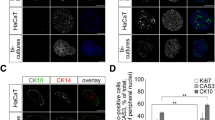Abstract
The growth of malignant tumors occurs in 3D environments and depends on the presence of a stromal component, which performs critical functions of tumor-cell protection and growth support. Therefore, the development and analysis of tumor models in 3D cell cultures in vitro, including coculture systems, hold significant interest. In this study, the results of 3D culturing of two human melanoma cell lines using the hanging drop method with and without human mesenchymal stem cells (MSCs) have been presented. The melanoma lines have been shown to behave differently in 3D cultures. In particular, the Mel Cher melanoma cells are capable of the formation of uniform spheroids within 24 h, whereas the MeWo cells failed to form spheroids even after 2 days of culture under similar conditions. However, in both cases, the coculturing of the melanoma cells with MSCs resulted in the formation of compact 3D cell spheroids. The visualization of MeWo cells and MSCs in mixed spheroids using fluorescent dyes revealed a certain clustering of the melanoma cells. The observed properties of the melanoma cells in homogeneous and heterogeneous spheroids may be used in the complex analysis of antimelanoma chemotherapy drugs and the estimation of their therapeutic properties.
Similar content being viewed by others
Abbreviations
- MSC:
-
human mesenchymal stem cell of adipose tissue
- DMEM:
-
Dulbecco’s modified Eagle Medium
References
Santini M.T., Rainaldi G., Indovina P.L. 2000. Apoptosis, cell adhesion and the extracellular matrix in the three-dimensional growth of multicellular tumor spheroids. Crit. Rev. Oncol. Hematol. 36, 75–87.
Yamada K.M., Cukierman E. 2007. Modeling tissue morphogenesis and cancer in 3D. Cell. 130, 601–610.
Kim J.B., Stein R., O’Hare M.J. 2004. Three-dimensional in vitro tissue culture models of breast cancer: A review. Breast Cancer Res. Treat. 85, 281–291.
Pastrana E., Silva-Vargas V., Doetsch F. 2011. Eyes wide open: A critical review of sphere-formation as an assay for stem cells. Cell Stem Cell. 8, 486–498.
Holtfreter J. 1944. A study of the mechanics of gastrulation. J. Exp. Zool. 95, 171–212.
Moscona A., Moscona H. 1952. The dissociation and aggregation of cells from organ rudiments of the early chick embryo. J. Anat. 86, 287–301.
Costchel O., Fadei L., Badea E. 1969. Tumor cell suspension culture on non adhesive substratum. Z. Krebsforsch. 72, 24–31.
Sutherland R.M., McCredie J.A., Inch W.R. 1971. Growth of multicell spheroids in tissue culture as a model of nodular carcinomas. J. Natl. Cancer Inst. 46, 113–120.
Kunz-Schughart L.A., Kreutz M., Knuechel R. 1998. Multicellular spheroids: A three-dimensional in vitro culture system to study tumor biology. Int. J. Exp. Pathol. 78, 1–23.
Khomyak A.G. and Sidorenko M.V. 2001. A model of spheroid formation and its applications in oncology. Eksp. Onkol. 23, 236–241.
Flach E.H., Rebecca V.W., Herlyn M., Smalley K.S., Anderson A.R. 2011. Fibroblasts contribute to melanoma tumor growth and drug resistance. Mol. Pharm. 8, 2039–2049.
Kucerova L., Matuskova M., Hlubinova K., Altanerova V., Altaner C. 2010. Tumor cell behaviour modulation by mesenchymal stromal cells. Mol. Cancer. 9, 129–144.
Go Y., Chintala S.K., Mohanam S., Gokaslan Z., Venkaiah B., Bjerkvig R., Oka K., Nicolson G.L., Sawaya R., Rao J.S. 1997. Inhibition of in vivo tumorigenicity and invasiveness of a human glioblastoma cell line transfected with antisense uPAR vectors. Clin. Exp. Metastasis. 15, 440–446.
Ivanov D.P., Parker T.L., Walker D., Alexander C., Ashford M.B., Gellert P.R., Garnett M.C. 2015. In vitro co-culture model of medulloblastoma and human neural stem cells for drug delivery assessment. J. Biotechnol. 205, 3–13.
Vartanian A., Stepanova E., Grigorieva I., Solomko E., Baryshnikov A., Lichinitser M. 2011. VEGFR1 and PKCa signaling control melanoma vasculogenic mimicry in a VEGFR2 kinase-independent manner. Melanoma Res. 21, 91–98.
Author information
Authors and Affiliations
Corresponding author
Additional information
Original Russian Text © O.F. Kandarakov, M.V. Kalashnikova, A.A. Vartanian, A.V. Belyavsky, 2015, published in Molekulyarnaya Biologiya, 2015, Vol. 49, No. 6, pp. 998–1001.
Rights and permissions
About this article
Cite this article
Kandarakov, O.F., Kalashnikova, M.V., Vartanian, A.A. et al. Homogeneous and heterogeneous in vitro 3D models of melanoma. Mol Biol 49, 895–898 (2015). https://doi.org/10.1134/S0026893315050106
Received:
Accepted:
Published:
Issue Date:
DOI: https://doi.org/10.1134/S0026893315050106




